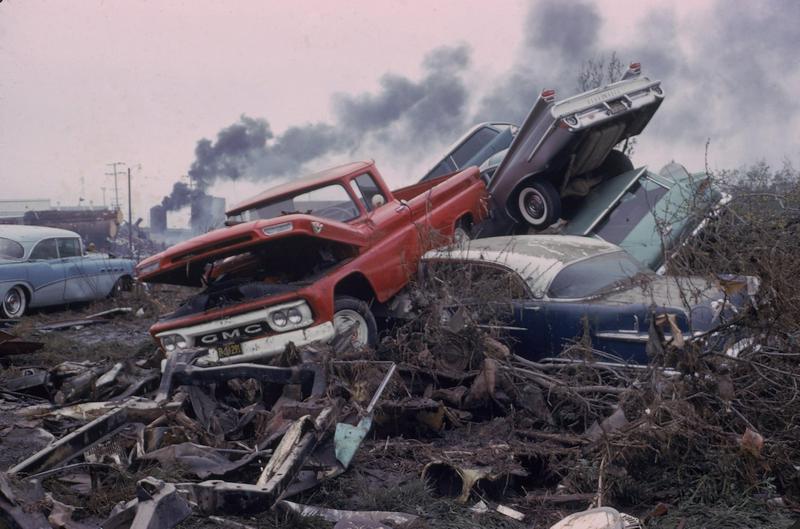The 1964 Good Friday Earthquake: Alaska's Armageddon
By | February 1, 2019

Those Alaskans who lived through it will never forget the calamity of March 27, 1964: the Good Friday Earthquake. Alaska is prone to earthquakes, moreso than California, and the Good Friday Earthquake, also known as the Great Alaska Earthquake, was "the big one." With a magnitude of 9.2, it's the most powerful quake ever to strike North America, and the second-strongest in recorded history. At 5:36 PM on Friday, March 27, 1964, fissures in the ground violently opened along a 600-mile fault, and for over four minutes the people living along it were shaken to the ground. Roads split open, houses crumbled, and the city of Anchorage suffered heavy damage.
Alaska's southern coast, like California's coastline, lies on the "ring of fire," where tectonic plates meet and seismic activity is frequent. Alaska, though, sees more than twice as many quakes as the lower 48. The Great Alaska Earthquake left 131 people dead, many of them killed by the ensuing tsunamis.
The Good Friday Earthquake Was The Second Largest Quake Ever Recorded

The magnitude of the Good Friday Earthquake registered 8.4 – 8.6 on the Richter scale and was reported as a 9.2 Moment Magnitude (Mw.) It is second only, in world history, to the earthquake that occurred in Chile in 1960, which registered a 9.5 Mw. Initial shocks from the Great Alaska Earthquake, as it was also known, lasted nearly five minutes (four minutes and 39 seconds to be exact) and homes and other structures, as well as the streets, were literally ripped apart by the massive shock waves, making it seem much longer. The city of Anchorage, Alaska was hit the hardest and was literally left in rubble. Scientific equipment is available to measure earthquake activity as it is happening, but this is not the same as an early warning system for preparedness.
Alaskans Were Preparing For The Easter Holiday With No Earthly Idea What Was About To Take Place

This catastrophic natural disaster resulted in six hundred miles of a fault being ruptured all at once. Approximately 500 years of “stress buildup” was released causing fissures and landslides resulting in devastating structural damage. Homes, other buildings, streets, sidewalks, water mains, and electrical systems were not properly engineered to withstand the magnitude of a severe earthquake, much less this one.
The Tsunamis Were Deadlier Than The Quake Itself

Shock waves of gargantuan proportions were triggered by the tragic Good Friday earthquake, causing a deadly tsunami. A tsunami is a mammoth-sized wall of water caused by an underwater eruption. The Good Friday Earthquake was the precursor to a tsunami of epic magnitude that was as deadly as the earthquake itself. Precious lives were lost as a result of people being trapped in collapsing buildings and drowning as a result of the devastating tidal waves.
Aftershocks From The Good Friday Earthquake Were Significant Quakes Themselves

Shock waves and other effects of the Good Friday earthquake were felt far beyond the borders of Alaska. The lethal earthquake affected not only Alaska but also California, Oregon, Hawaii and parts of Texas with loss of life and property damage. Canada was directly affected reporting 55 casualties. Other countries around the world were indirectly affected by declining water levels in their wells as a result of the tsunami.
Some of the aftershocks of the Good Friday earthquake registered higher than 6.0, making them significant earthquakes in their own right.
Aftershocks Continued For Over A Year

Hundreds of aftershocks followed in the next few weeks following the main shock of the Good Friday Earthquake. As early as March 28, 1964, just one day after the main shock, eleven major aftershocks were recorded registering more than 6.0. Within the next three weeks, nine more aftershocks struck with thousands to follow in the months to come. Much smaller aftershocks continued to occur in excess of one year.
Damage From The Good Friday Earthquake Was Severe

In Anchorage, the newly completed Four Seasons hotel was demolished in the quake, while some villages on the Alaskan coast were completely destroyed. At the Anchorage International Airport, the control tower collapsed, killing the air traffic controller within. The Good Friday Earthquake displaced miles upon miles of land, left behind $311 million (1964 USD) in property damage and caused a death toll of 139 in all. Many of the deaths occurred far from the quake, as a result of the massive tsunami waves catching coastal residents unawares.
